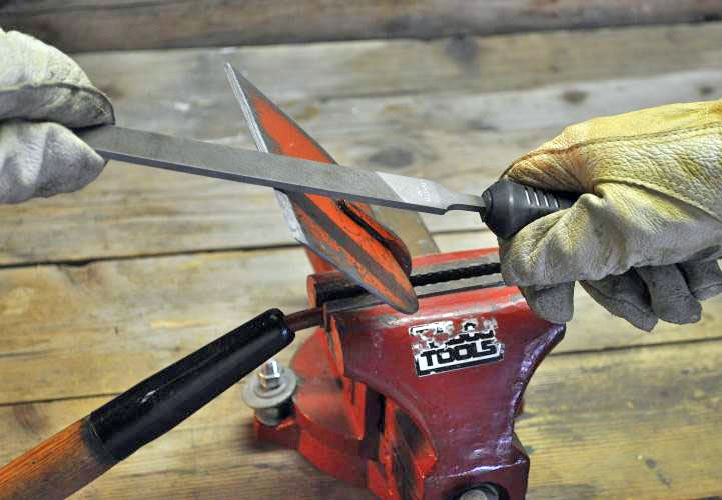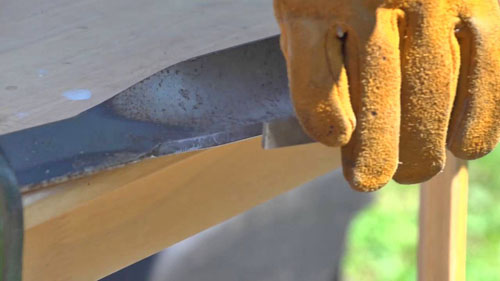Spring Cleanup of Gardening Tools
by Ernie Ruckert, Fairfax Master Gardener
 The seed catalogs are arriving in the mail. Time to stock up on seed starting supplies. The weather temperature is swinging up to the 50’s and down into the 20’s. It will still be a while for the continuous rising temperatures that we are all looking forward to when we start setting out the transplants. One thing may be missing from your gardening planning list – preparing your tools for spring. Actually, many of the items listed below could become part of your gardening routine throughout the growing season. If you’d rather do these at one time, plan on cleaning up your tools in November after the growing season is over (unless you continue on with winter vegetable gardening). However, if you are like me and put things off, spring is the time for tool cleanup.
The seed catalogs are arriving in the mail. Time to stock up on seed starting supplies. The weather temperature is swinging up to the 50’s and down into the 20’s. It will still be a while for the continuous rising temperatures that we are all looking forward to when we start setting out the transplants. One thing may be missing from your gardening planning list – preparing your tools for spring. Actually, many of the items listed below could become part of your gardening routine throughout the growing season. If you’d rather do these at one time, plan on cleaning up your tools in November after the growing season is over (unless you continue on with winter vegetable gardening). However, if you are like me and put things off, spring is the time for tool cleanup.
As there are different needs for tool cleanup based on the type of tool, here is cleanup information based on general categories of tools, starting with the workhorse — the trowel.
Trowels usually require cleaning of the blades and the handles if they are made of wood. To clean rust off of the steel blade, first scrape off dirt from the trowel, wash the trowel with water and dry the trowel. Use steel wool, a wire brush, or fine sandpaper to remove the rust. Apply a small amount of boiled linseed oil (derived from flax seeds), tung oil, or mineral oil to the blade to help remove heavy rust. Note that whatever amount of oil you put on the blade, it will rub off into the soil when you use the trowel, so use the oil sparingly and lightly dry the trowel.
You can dedicate a pail (say a 5-gallon size) for cleaning off the rust and for storing your trowels between uses. Fill the pail half full of sand and add some oil (use a plant-based oil in lieu of a petroleum-based oil). After cleaning the rust off of the blade, push the trowel into the sand a few times. The oil in the sand will coat the blade and help to keep the rust under control. Plus, using this bucket approach may help to organize and store your hand tools inside your shed.
If your trowel has a wooden handle, lightly sand the handle with a 120 to 150 grit sandpaper and apply boiled linseed oil with a clean rag to the wood handle. Let it set for about 10 to 15 minutes and wipe the remaining oil off with a clean part of the rag. Do not store these rags in an enclosed container. The treated handle will air dry quickly.
 Clippers and pruning shears should be sharpened with a steel file, such as a flat mill file. File at the same angle as the cutting edge. You do not have to remove much steel to sharpen the blade. Apply a small amount of light machine oil to the hinge. Wipe the clippers and pruning shears with a disinfectant wipe or isopropyl alcohol. The jury is out regarding the use of bleach for disinfecting tools. If you use a bleach solution, rinse with water to remove any bleach residue, as bleach can cause pitting of sharpened blade edges. Disinfecting should actually be done while you are using the clippers and pruning shears during the growing season to disinfect them from bacteria and fungi. As a quick note, I tie a couple of inches of bright fluorescent pink surveyor’s tape to each of the handles to help me locate the clippers (and trowels for that matter). I’ve learned this after spending too much time locating these hand tools in that place where I won’t forget where they are!
Clippers and pruning shears should be sharpened with a steel file, such as a flat mill file. File at the same angle as the cutting edge. You do not have to remove much steel to sharpen the blade. Apply a small amount of light machine oil to the hinge. Wipe the clippers and pruning shears with a disinfectant wipe or isopropyl alcohol. The jury is out regarding the use of bleach for disinfecting tools. If you use a bleach solution, rinse with water to remove any bleach residue, as bleach can cause pitting of sharpened blade edges. Disinfecting should actually be done while you are using the clippers and pruning shears during the growing season to disinfect them from bacteria and fungi. As a quick note, I tie a couple of inches of bright fluorescent pink surveyor’s tape to each of the handles to help me locate the clippers (and trowels for that matter). I’ve learned this after spending too much time locating these hand tools in that place where I won’t forget where they are!
Long handled tools, including shovels, rakes, hoes, weeders and edgers, need spring cleanup also. To clean rust off of the steel portions of the implements, first scrape off dirt as best you can, wash with water and dry the tools. Use steel wool, a wire brush, or fine sandpaper to remove the rust. Use a bleach solution by immersing the metal portion of the tool in a 10 percent bleach solution. Pitting of these implements is not as harmful as bleach caused pitting of sharp edged blades. After drying, follow with a small application of boiled linseed oil, tung oil or mineral oil. Lightly dry the tool with a rag.

Sharpen lawnmower blade
For lawn mowers, sharpen the blades with a mill file. It is a good idea to have two sets of lawnmower blades, so when you have to take one set of blades off, you have a second set ready to put onto the mower. You can sharpen the second set anytime. With two sets of sharpened blades, you will get more than half way through the mowing season, assuming you sharpen the blades three times per growing season. In the fall, add fuel saver to the fuel tank so you do not have to drain the fuel tank and dispose of the unused gasoline. Change the oil and take the used oil to the Fairfax County solid waste facility or one in your area for disposal. Replace the spark plug or clean the plug with a wire brush. Don’t forget to check wires and cables to see if there has been any damage to these and repair as necessary.
And who doesn’t have a wheelbarrow? Check the tire pressure if you have pneumatic tires and inflate to recommended pressure imprinted on your tire sidewall. For solid tires, check for damage to the tire, such as cuts in the tread or a piece of tire tread missing. Replace the tire as needed. Apply lubricating oil to the axle or wheel bearings. For wooden handled wheelbarrows, lightly sand the handles with a 120 to 150 grit sandpaper and apply boiled linseed oil with a clean rag to the wood handle. Let it set for about 10 to 15 minutes and wipe the remaining oil off with a clean part of the rag. Do not store these rags in an enclosed container. The treated handle will air dry quickly. If possible, store the wheelbarrow under cover to provide protection from the weather.
Although work gear are not tools, per se, check your supplies of work gloves, hats and sunglasses for sun protection, and high SPF sun-tan lotion. Check the condition of your work boots or gardening shoes and apply a waterproofing or dressing if needed.
Enjoy tending to your plants during the growing season with your spring-cleaned garden tools.
Resources
Clean and Disinfect Gardening Tools and Containers, Julie Weisenhorn, Natalie Hoidal and Annalisa Hultberg, University of Minnesota Extension
Winter Tool Care, Elaine Mills, Mary Resnick and Anne Reed, Master Gardeners of Northern Virginia
Home Turf — A Healthy Virginia Lawns Program, Fairfax County Master Gardener Association